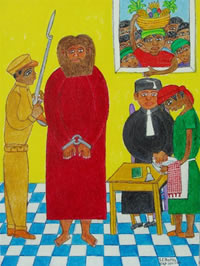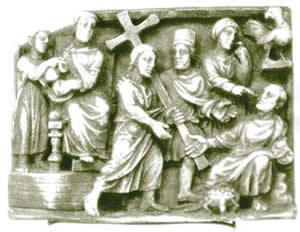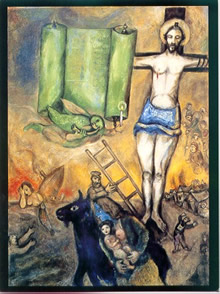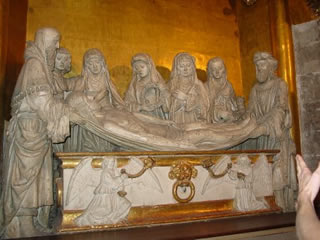From Our Archives
Three essays by Debie Thomas on Palm Sunday, Save Us, We Pray (2021); Parade or Protest? (2018); and The Clown King (2015).
For Sunday March 24, 2024
Sixth Sunday in Lent
Lectionary Readings (Revised Common Lectionary, Year B)
Mark 11:1-11 or John 12:12-16
Psalm 118:1-2, 19-29
This Week's Essay
The gospel reading from Mark 11 brings us to the last week in the life of Jesus. That one week begins with his "triumphal entry" into Jerusalem at Mark 11:1, and occupies a full 40% of Mark's gospel. That percentage increases to well over 50% of Mark if we start the "end" of his story at 8:31, when Jesus "spoke plainly" about his suffering, death, and resurrection, and rebuked Peter for trying to dissuade him. Many readers thus describe Mark as a long passion narrative with a short introduction.
And not only that. Consider further the granular detail about the last week of Jesus that Mark provides. As Marcus Borg and John Dominic Crossan show in their book The Last Week; A Day-by-Day Account of Jesus's Final Week in Jerusalem (2006), Mark "time stamps" the last eight days of Holy Week. He even specifies "morning" and "evening" for three of these days:
|
|
|
Macedonian icon of Jesus's Triumphal Entry (13th century).
|
Palm Sunday: "When they were approaching Jerusalem" (11:1)
Monday: "On the following day" (11:12)
Tuesday: "In the morning" (11:20)
Wednesday: "It was two days before the Passover" (14:1)
Maundy Thursday: "On the first day of Unleavened Bread" (14:12)
Good Friday: "As soon as it was morning" (15:1)
Holy Saturday: "The Sabbath" (15:42, 16:1)
Easter Sunday: "Very early on the first day of the week" (16:2)
And if that was not precise enough, Mark describes what happened at five three-hour intervals on Good Friday.
Mark is the earliest of the four gospels, and the primary source for Matthew and Luke. With his long and detailed description of passion week, Jesus is much more than a teacher-healer or rebel rabbi. For those first followers who were understandably shocked, discouraged, and disoriented at the violent and ignominious death of Jesus, Mark makes it clear — his death was not incidental or accidental. Rather, the ultimate meaning and message of Jesus resides precisely in his death and resurrection for all the world.
 |
|
Jesus before Pilate, Seymour E. Bottex, Haiti.
|
But let us backtrack to the beginning. In her Magnificat, Mary proclaimed that with the birth of Jesus God would "bring down rulers from their thrones, fill the hungry with good things, and send the rich away empty" (Luke 1:52–53). The aged Simeon uttered a dark prophecy to the young mother: "This child is destined to cause the falling and rising of many in Israel, and to be a sign that will be spoken against" (Luke 2:34). Mary and Simeon strip away all sentimentality about this baby's future.
After living in total obscurity his entire life, Jesus burst onto the stage of history with a provocative invitation and indictment: "Repent! The kingdom of God is at hand" (Mark 1:15). There's a new rule and a new reign, he said. Mary's song about toppling political and economic powers, and Jesus's inauguration of an alternate social vision, thus set him on a collision course with the religious and political powers of his day.
For three years Jesus criss-crossed the villages of Galilee, teaching in synagogues, preaching the good news of God’s kingdom, and healing the sick. Rumors spread like wild fire. The dregs of society flocked to him — the diseased, epileptics, paralytics, the poor, prisoners, crazy people with demons, and "those suffering severe pain" (Matthew 4:24). Gawkers trampled each other just to get a look at him. Some people responded positively to Jesus, for reasons that were both good and bad. Many others responded with rejection, resistance, and unbelief. Some of his closest followers stopped following him. His family tried to apprehend him, and his hometown tried to kill him. To say that at the end of those three years Jesus was a controversial figure would be a gross understatement.
 |
|
The Condemnation of Christ and the Denial of Saint Peter, early fifth century, British Museum.
|
Those three years culminated in the last week of his life, when Jesus “resolutely set his face toward Jerusalem.” When he entered that city for the last time, knowing full well that betrayal, persecution and death awaited him, it’s easy to imagine that he was greeted by his largest and most boisterous crowd. His so-called “triumphal entry” triggered the beginning of the end for Jesus.
What began on Palm Sunday with a festive religious procession ended on Good Friday with a public display of state terror. Excited children waving palm branches were quickly forgotten when violent mobs shouted death threats. The adulation of the crowds evaporated into abandonment by his closest friends.
During that one last week, Jesus's disciples argued among themselves about who was the greatest, Judas betrayed him, Peter denied knowing him, all his disciples fled (except for the women), and Rome employed all the brutal means at its disposal to crush an insurgent movement — rendition, interrogation, torture, mockery, humiliation, and then a sadistic execution designed as a "calculated social deterrent" (Borg) to any other trouble makers who might challenge imperial authority.
Jesus's "triumphal entry" into the clogged streets of Jerusalem on Good Friday was a deeply ironic, highly symbolic, and deliberately provocative act. It was an enacted parable, or a brilliant piece of street theater, that dramatized his subversive mission and message. He didn't ride a donkey because he was too tired to walk or because he wanted a good view of the crowds. The Oxford scholar George Caird characterized Jesus's triumphal entry as more like a "planned political demonstration" than the religious celebration that we sentimentalize today.
 |
|
Marc Chagall, "Yellow Crucifixion" (1943).
|
Because the Roman state always made a show of force during the Jewish Passover when pilgrims thronged Jerusalem to celebrate their political liberation from Egypt centuries earlier, Borg and Crossan imagine not one but two political processions entering Jerusalem that Friday morning in the spring of AD 30. In a bold parody of imperial politics, king Jesus descended the Mount of Olives into Jerusalem from the east in fulfillment of Zechariah's ancient prophecy: "Look, your king is coming to you, gentle and riding on a donkey, on a colt, the foal of a donkey" (Matthew 21:5 = Zechariah 9:9). A king on a colt?! From the west, the Roman governor Pilate entered Jerusalem with all the pomp of state power. Pilate's brigades showcased Rome's military might, power and glory. Jesus's triumphal entry, by stark contrast, was an anti-imperial and anti-triumphal "counter-procession" of peasants that proclaimed an alternate and subversive community that for three years he had called "the kingdom of God."
Luke says that Jesus was executed for three reasons: "We found this fellow subverting the nation, opposing payment of taxes to Caesar, and saying that He Himself is Christ, a King" (Luke 23:1–2). In John's gospel the angry mob warned Pilate, "If you let this man go, you are no friend of Caesar. Anyone who claims to be a king opposes Caesar" (John 19:12).
People today argue about who's "subverting our nation." Here in the United States, some people blame illegal immigrants for our problems. Others worry about Christian nationalism. The MAGA movement and Woke Liberals are regular targets. The list goes on. But I’ve never heard anyone say what Luke says — that Jesus is the one who's "subverting our nation." But that was the allegation that sent Jesus to Golgotha. He had "incited a rebellion" (Luke 23:12).
What were Jesus and his followers subverting? We know that the earliest believers were called "atheists" because they refused to participate in Rome's cult of imperial worship. They were also despised as a "third race" that marginalized itself from the "first race" (Greeks and Romans) and the "second race" (Jews). The question of subversion is complicated and deserves a lifetime of reflection, but a simple summary by Borg and Crossan makes a good beginning.
 |
|
Burial of Christ, Cathédrale d'Auch (France).
|
Jesus's alternate reign and rule, they argue, subverted major aspects of the way most societies in history have been organized. Whether ancient or modern, most societies have normalized a status quo of political oppression that marginalizes ordinary people, economic exploitation whereby the rich take advantage of the poor, and religious legitimation that insists that "God wants things this way." It's easy to think of other components of the cultural status quo that Jesus might also subvert, like ethnic stereotypes, media propaganda, gender roles, consumerism, and our degradation of planet earth.
On Palm Sunday, Jesus invites us to join his subversive counter-procession into all the world. But he calls us not just to any subversion, subversion for its own sake, or to some partisan political agenda. Rather, Christian subversion takes as its model Jesus himself, "who, being in very nature God, did not consider equality with God something to be grasped, but made himself nothing, taking the very nature of a servant, being made in human likeness. And being found in appearance as a man, he humbled himself and became obedient to death — even death on a cross."
A JWJ reader recently sent me the Lenten message by Pope Francis from a few years ago. I pass it along as a wonderfully subversive end to this season of Lent, and the beginning of Holy Week this Palm Sunday that anticipates resurrection life. Do you want to fast this Lent, the pope asked rhetorically? Then...
- Fast from hurting words… and say kind words.
- Fast from sadness…and be filled with gratitude.
- Fast from anger…and be filled with patience.
- Fast from pessimism…and be filled with hope.
- Fast from worries…and have trust in God.
- Fast from complaints…and contemplate simplicity.
- Fast from pressures…and be prayerful.
- Fast from bitterness…and fill your hearts with joy.
- Fast from selfishness…and be compassionate to others.
- Fast from grudges…and be reconciled.
- Fast from words…and be silent so you can listen.
Amen.
Weekly Prayer
Georgetown Poems (5)
Daniel BerriganThe suburbs are sad as death
the university slumps on its arse
money dreaming of money.
Washington DC, a whitewashed sepulchre
awaits the diggers of history
side by side, tombs, slums, imperial empathy.Amid all this
the transfixed tourists
the international pimps
the wheelers and dealers
rolling along like chariot wheels of fate
the faces like faces on dollars—amid all this
did one original mind
cry out a gospel versepanic in the streets!
tumbling whirlwinds!
the unbearable halo
of resurrected Christ!From Daniel Berrigan, And the Risen Bread; Selected Poems, 1957–1997 (1998).
Dan Clendenin: dan@journeywithjesus.net
Image credits: (1) Open Society Institute of Macedonia; (2) Arte del Pueblo: Latin American & European Arts; (3) The Museum of Antiquities Collection, University of Saskatchewan; (4) Jeremy D. Popkin, Universtiy of Kentucky; and (5) Futur Quantique.





